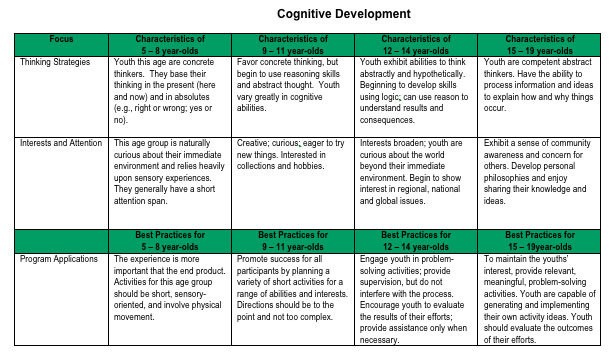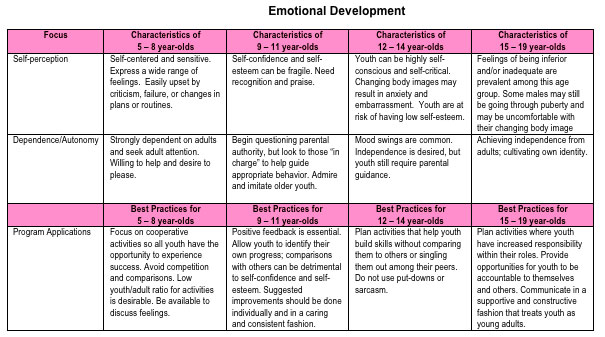 |
February 2011
|
February 2011 // Volume 49 // Number 1 // Ideas at Work // v49-1iw1
Preparing Volunteers to Meet the Developmental Needs of Youth Audiences
Abstract
4-H volunteers and staff are often faced with providing educational programs and opportunities for youth with wide ranges of age and ability. To address this challenge, researchers from the University of California Cooperative Extension developed and tested a Best Practices Matrix that outlines domain-specific, age-appropriate characteristics of youth and their applications to 4-H programming. Post-implementation surveys that included six forced-response and five open-ended questions were collected from 48 adult volunteers who attended volunteer development workshops. Outcomes indicated that participants improved their understanding of youths' developmental characteristics and how to use the matrix to help improve their project and activities.
Introduction
Volunteers are most commonly involved in the 4-H Youth Development Program as non-formal educators who lead projects and activities with youth (Boyd, 2004). Over 550,000 adults are engaged in this capacity nationally on an annual basis (USDA, 2006), and without their commitment of time and energy, the 4-H Youth Development Program could not operate effectively (Boyd; Stedman & Rudd, 2006). However, to be effective, volunteers must have access to training opportunities and educational resources (Hoover & Connor, 2001).
Effective teaching requires that educators differentiate their instruction to meet the needs of their learners (Anderson, 2007). Differentiated instruction means understanding the differences between learners and applying this understanding to planning lessons that maximize the educational impacts on the individuals involved (Anderson, 2007). Differences such as learning styles, skills, and interests can have profound effects on whether or not an educational activity achieves the desired learning outcomes (Anderson, 2007).
In 4-H, projects and published curricula are typically organized around or designed according to specific age groups: 5-8 year-olds, 9-11 year-olds, 12-14 year-olds, and 15-19 year-olds. These groupings are not random; rather, they are based on research related to the developmental characteristics of youth that are both linear (e.g., physical size) and dynamic (e.g., behavior) (Katz, 1996). However, because 4-H projects and activities frequently include youth of mixed age groups, understanding these developmental characteristics becomes essential to volunteers as they plan and implement programs.
Addressing Developmental Characteristics of Youth: A Best Practices Matrix
The developmental characteristics of youth are categorized according to ages and domains of youth development (i.e., physical, cognitive, social, emotional). For each of the four defined age groups, there are specific developmental characteristics within each of the four domains. Characteristics of youth are age specific within each domain and thus have implications relative to the design and implementation of 4-H projects and activities. According to Silliman (2007), it is important to understand and use these domains effectively when planning 4-H programs, and that by doing so, practitioners can "improve their knowledge and skills" (p. 6).
Based on Silliman's (2007) work and results from a statewide survey of 4-H staff in California (Dasher et al., 2005), it was determined that a comprehensive resource on youth development concepts that included strategies for authentic application was needed for volunteers. To aid in addressing this need, Extension personnel from the University of California developed the Best Practices Matrix (Figure 1) that outlines domain-specific, age-appropriate characteristics of youth, applicable to 4-H programming. Anchored in similar work (McFarland et al., n.d.; Levings, 2006; Ponzio, Junge, Manglallan, & Smith, 2000; Smith, 1994; Tomek & Williams, 1999), the Best Practices Matrix provides educators a resource to compare developmental characteristics within different domains and across four age groups, or focus on characteristics within each age group and/or domain individually. What distinguishes this matrix from most previous work is the inclusion of best practices that provide practitioners with examples of potential program applications.
Figure 1.
Best Practices Matrix




Methods
The Best Practices Matrix was field-tested with 4-H volunteers through interactive workshops. Volunteers were asked to draw upon their prior knowledge and experience, and use the Best Practices Matrix to plan an event or activity for 4-H youth using project group profiles provided by the workshop facilitators. Project group profiles were designed to simulate 4-H project rosters and included information such as youths' ages and genders, size of groups, and the number of years enrolled in 4-H. The participants used the Best Practices Matrix as a reference to help guide them in the development of activities that addressed domain-specific, age-appropriate characteristics of the youth represented in the profiles.
At the conclusion of the workshops, participants were asked to complete a survey that included six forced-response and five open-ended questions. The purpose of the survey was to assess participants' understanding of the developmental characteristics of different age groups, the Best Practices Matrix, and how they intended to use this tool in their future work as 4-H volunteers.
Results
Survey results were collected from 48 adult volunteers who attended one of five workshops. Participants represented an array of volunteer roles, including project leaders, community club leaders, and council officers, with an experience in a variety of delivery modes (e.g., clubs, camps, afterschool programs). Seventy percent of the participants had less than 5 years of experience as 4-H volunteers; 10% had 6-10 years of experience; 10% had more than 15 years; and 10% did not indicate their level of experience. Specific survey results revealed the following.
- 92% of workshop participants agreed or strongly agreed that their understanding of the differences between cognitive, emotional, social, and physical development was better after participating in the workshop than before. Open-ended responses from participants suggested that they would apply information such as knowing when to insert fine-motor tasks into projects and activities, and how domain-specific characteristics associated with different age groups can affect youths' interests.
- 90% of the participants agreed or strongly agreed that they had a better understanding of age-specific developmental characteristics of youth after attending the workshop than before. They commented that they believed this understanding would allow them to better meet the needs of 4-H youth in their programs by choosing activities and tailoring projects for different ages.
- 92% agreed or strongly agreed that they would be able to use the Best Practices Matrix to assist them in project planning, training and teaching others, and working with teen and junior leaders.
- 94% of the participants agreed or strongly agreed that other 4-H volunteers would benefit from participating in a similar workshop.
Discussion
Effective volunteer development is critical to the success of the 4-H Youth Development Program (Hoover & Connor, 2001; Kaslon, Lodl, & Greve, 2005; Smith, Meehan, Enfield, George, & Young, 2004; Van Winkle, Busler, Bowman, & Manooigan, 2002). One component of effective volunteer development is to provide materials and informational resources necessary to support volunteers in successfully executing their responsibilities as non-formal educators (Kerka, 2003; Tingley, 2001). The Best Practices Matrix can help staff provide critical information related to core competencies for volunteers identified by Culp, McKee, and Nestor (2001) and help volunteers understand what is expected of them in their role within the 4-H Program.
The Best Practices Matrix can also benefit 4-H volunteers by serving as a practical resource that builds their capacity to organize, plan, and deliver educational projects and activities for youth. Most important, however, is that by understanding the needs of youth as learners and incorporating those requirements and conditions into 4-H programming, the possibility that youth will learn through positive, developmentally appropriate experiences will be enhanced.
Conclusion
Differentiated instruction is an important element of effective teaching (Anderson, 2007). The learning styles, skills, and interests of target audiences must be considered and addressed if desired learning outcomes of educational interventions are to be achieved (Anderson, 2007). The Best Practices Matrix is a comprehensive resource that outlines domain-specific, age-appropriate characteristics of youth and is applicable to 4-H programming. The matrix can be used to enhance volunteer development and educational programming and can help 4-H staff build and maintain a volunteer corps, elements that have been identified as necessary for successful county-based educational programming (Subramaniam, Heck, & Carlos, 2008; Van Winkle, Busler, Bowman, & Manoogian, 2002).
References
Anderson, K. M. (2007). Differentiating instruction to include all students. Preventing School Failure, 51(3): 49-54.
Boyd, B. L. (2004). Extension agents as administrators of volunteers: Competencies needed for the future. Journal of Extension [On-line], 42(2) Article 2FEA4. Available at: http://www.joe.org/joe/2004april/a4.php
Culp, K., McKee, R. K., & Nestor, P. (2007). Identifying volunteer core competencies: Regional differences. Journal of Extension, [On-line], 43(5) Article 6FEA3. Available at: http://www.joe.org/joe/2007december/a3.php
Dasher, H. S., Frazell, J., Gregory, P. F., Pollard, M. Y., Schmitt-McQuitty, L., Snell, D., Sousa, C., & Young., J. Volunteer development survey. Unpublished manuscript, Division of Agriculture and Natural Resources, University of California, Davis, CA.
Hoover, T., & Connor, N. J. (2001). Preferred learning styles of Florida association for family and community education volunteers: implications for professional development. Journal of Extension [On-line], 39(3) Article 3FEA3. Available at: http://www.joe.org/joe/2001june/a3.php
Kaslon, L., Lodl, K., & Greve, V. (2005). Online leader training for 4-H volunteers: A case study of action research. Journal of Extension [On-line], 43(2) Article 2FEA4. Available at: http://www.joe.org/joe/2005april/a4.php
Katz. L. G. (1996). Child development knowledge and teacher preparation: Confronting assumptions. Early Childhood Research Quarterly, 11(2), 135-146.
Kerka, S. (2003). Volunteer development (Practice Application Brief No. 26). Columbus, OH: ERIC Clearinghouse on Adult, Career, and Vocational Education. (ERIC Document Reproduction Service No. ED475 111)
Levings, J. (December, 2006). Iowa State University. How kids develop: Ages and stages of youth development. Iowa 4-H Volunteer. Iowa State University, University Extension. Retrieved February 15, 2011 from: https://www.extension.iastate.edu/4H/Documents/VI950902FAgesStages.PDF
McFarland, M., Betts, S.C., Walker, J.E., Mancini, J., Goggin, S., Huebner, A., Bonner, L. (n.d.). Moving ahead, Preparing the youth development professional. U.S. Army Community and Family Support Center and the U.S. Department of Agriculture, Cooperative State Research, Education, and Exrtension Service under Kansas State University. #95-EXCA3-0378. Session V, pages LP 63 - 72 and pages 53 - 72.
Ponzio, R., Junge, S., Manglallan, S., & Smith, M. (2000). Youth experiences in science project. University of California Cooperative Extension, Division of Agriculture and Natural Resources. Section 3, pages 61 - 76.
Silliman, B. (2007). Critical indicators for youth development outcomes for 4-H national mission mandates. National 4-H Headquarters. Retrieved February 15, 2011 from: http://www.national4-hheadquarters.gov/library/Indicators_4H_MM.pdf
Smith, B. A. (1994). New Jersey 4-H leader training series, Working with 4-H youth in 1st to 3rd grades. Rutgers Cooperative Extension, New Brunswick New Jersey. Pages 403 - 404.
Smith, M. H., Meehan, C. L., Enfield, R. P., George, J. L., & Young, J. C. (2004). Improving county-based science programs: Bringing out the science teacher in your volunteer leaders. Journal of Extension [On-line], 42(6) Article 6FEA5. Available at: http://www.joe.org/joe/2004december/a5.php
Stedman, N. L. P. & Rudd, R. (2006). Leadership styles and volunteer administration competence: Perceptions of 4-H county faculty in the United States. Journal of Extension [On-line], 44(1) Article 1RIB6. Available at: http://www.joe.org/joe/2006february/rb6.php
Subramaniam, A., Heck, K., & Carlos, R. (2008) 4-H staff professional development: Identifying training needs across the state. Monographs of the 4-H Center for Youth Development, Winter 2008. Available at: http://cyd.ucdavis.edu/publications/pubs/report/pdf/cyd_report_08summer.pdf
Tingley, J. (2001). Volunteer programs: When good intentions aren't enough. Educational Leadership, 58(7): 53-55.
Tomek, J., & Williams, M.J. (1999). Ages and stages of 4-H youth development. University of Missouri Extension, University of Missouri-Columbia. LG 782.
Van Winkle, R., Busler, S., Bowman, S., & Manoogian, M. (2002). Adult volunteer development: Addressing the effectiveness of training new 4-H leaders. Journal of Extension [On-line],40(6) Article 6FEA4. Available at: http://www.joe.org/joe/2002december/a4.php




